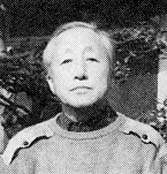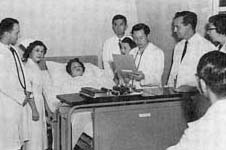Memories of the Happy Days of Youth
by Hideya Tamagaki, M.D.
Department of Medicine, 1949-65

Hideya Tamagaki, M.D.
One night last September I visited Dr. and Mrs. Schull in their apartment in Hijiyama Hall, along with some 30 people including members of the former Genetics Department and nurses who had worked together.
We reminisced about the pleasant times and the difficulties we had had and about the various activities like picnics that we had enjoyed together. Although we had been in want of commodities and food then, almost all of us including Dr. Schull were still in our twenties and those youthful days were so fondly recalled that our conversation made us lose track of time. We parted promising to meet each other again.
I still remember going from house to house riding on a jeep over the unpaved bumpy streets of the city covered with dust, even to a shack under a bridge to examine a baby, and also the days when we occupied a rented room on the second floor of the Japan Red Cross Hospital. The Genetics Department was later abolished and became the Department of Medicine, and the No.5 Fukuryu Maru Incident occurred soon thereafter (1954). Members of ABCC were dispatched to Yaizu as an American investigation group. It was our understanding at first that we would be able to carry out examinations together with the Japanese medical team. However, public opinion in the country had become very unfavorable by the time we were dispatched as the second group, and we only waited on standby in a room in an annex of the US Embassy. In the end, we returned without being permitted to make a single examination.
In order to maintain the initial good examination rate, special attention was paid to arrangements for the reception of the examinees visiting the Commission to cooperate in the study. In the orientation of new doctors, we always stressed the importance of attending to ABCC patients differently from those of hospitals in general. This, of course, was recognized not only by the department concerned with medical examinations, but also by the entire ABCC staff. I once went out myself to persuade a small number of refusal cases to come for examination. I was heaped with reproaches by all of them, which made me aware of the depth of the mental and physical injury each of them had sustained. I experienced at the same time the trouble to which the contractors had to go to gain the cooperation of a single person.

Physicians go the round of inpatients.
Although my 17 years with the Commission was a period during which I met with many such happenings, incidents and difficult problems, I gained much indeed during that time. I am personally thankful from the bottom of my heart especially for the rare opportunity to spend a splendid time in Washington around the time of President Kennedy’s inauguration. I not only had the chance to study medicine but also the opportunity to observe the presidential election and how the young hospital staff addressed the racial discrimination problem that arose then, and to see the President close at hand in the hospital hallway as he frequently visited his wife who was hospitalized for childbirth. (Tamagaki Clinic, Hiroshima City)
This article was originally published in RERF Newsletter 14 (40th anniversary special issue): 62-63, 1988

